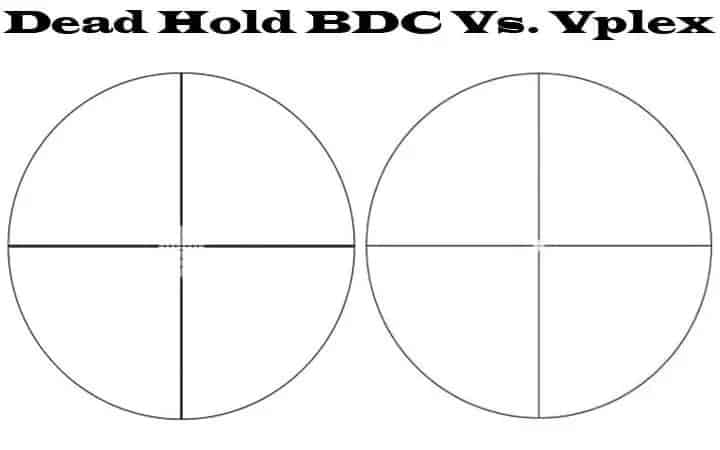
When it comes to choosing a rifle scope, there’s a lot of factors that you have to consider. Magnification, reticle, windage, elevation, and many other features that will affect your usage and how you shoot. However, when it comes to optics, there’s a couple brands that immediately come to mind for a veteran shooter. One of the most prominent brands is Vortex.
Vortex Optics has been around for a long time and they offer a ton of rifle scope options and reticles. They are most known for the immense amount of different reticles that they offer in a Vortex rifle scope. Today, we will be discussing the Dead Hold BDC Reticle and the V Plex reticle. Both of these are very popular from the Vortex scope line and have their pros and cons.
What is the Dead Hold BDC Reticle?
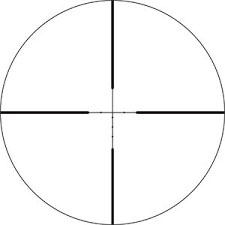
Before we discuss the reticle itself, there’s some other concepts behind the BDC that should be discussed in order to understand this reticle to its full potential.
What Does BDC Mean?
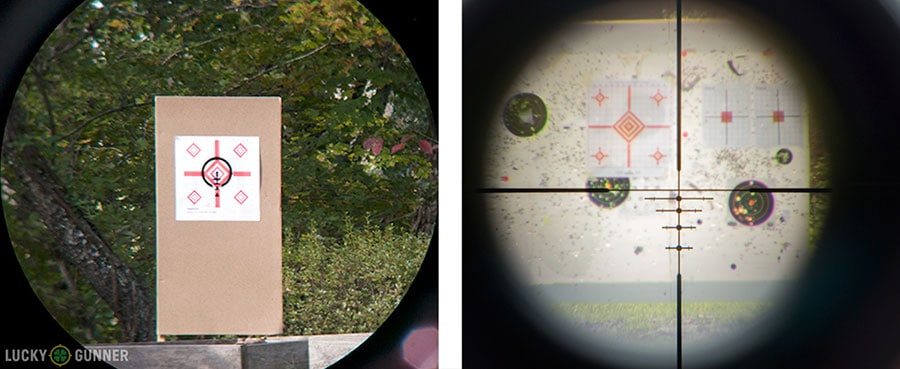
BDC in the rifle world stands for Bullet Drop Compensator. What that means is the riflescope will account for and allow you to accommodate your shot for the bullet drop over different distances. Bullet drop means that when you fire your rifle, the bullet will inevitably fall a little towards the bottom of your target because of the bullet weight, caliber, distance (usually in yards), bullet speed, and other environmental conditions like weather. This is especially devastating in target shooting at longer distances.
A BDC reticle will allow you to have improved accuracy because you will be able to account for that bullet drop when either long range shooting or short range shooting. However, it will have to be adjusted and set to account for certain rifles and calibers in order to gain that improved accuracy.
However, basic BDC features that are built into a riflescope will only need the information of the distance away that your target stands. This way, you can use the BDC feature to your advantage without having to do complex ballistic calculations before every shot. Which would be a huge inconvenience for most people.
The Dead Hold BDC
Now that we’ve gone over the definition of BDC, let’s talk about the Vortex Optics Dead Hold BDC reticle. This reticle option has by far been one of the best selling reticles that is offered by Vortex. While it offers plenty of great features, it still remains in the affordable zone, making it a great choice for average shooters who don’t want to break the bank.
While this optic is not exactly made for longer distances, its features allow the shooter to conduct long range shooting with ease, which is great for hunting and target shooting.
The reticle itself has thicker lines that serve as the crosshair lines for the reticle picture. Those vertical and horizontal lines even out into a duplex reticle at the center of the scope. On the bottom of the duplex reticle, there are 3 BDC featured marks that allow you to compensate for basic bullet drop. These will help the shooter estimate the amount of holdover that will be needed for improved accuracy.
Along with that, there’s also 3 marks on either side of the reticle. These marks are the windage adjustments, which will allow you to compensate for things like wind or other factors that might push your bullet off to one side or the other.
Now, since this optic is meant to work for all kinds of calibers and rifles, there’s firearm classes and sighting distances that are provided by Vortex Optics that are recommended to get the most out of the Dead Hold. See the following chart for the recommended distances for different calibers.
| Firearm Class | Calibers/Rifles | Min. Effective Distance | Max. Effective Distance | Rec. Sighting Distance |
Class A | Traditional high-power calibers like .270, .308, 30-06 | 100 yards | 500 yards | 100 yards |
Class B | Magnum calibers like .300 Win Mag, .338 Lapua, 7mm Mag | 100 yards | 600 yards | 200 yards |
Class C | High velocity smaller caliber cartridges like .204 Ruger, .22-250, 6.5 Creedmoor | 100 yards | 650 yards | 200 yards |
Class D | Modern all lives power rifles in most any caliber | 50 yards | 225 yards | 100 yards |
| Class E | .22 LR caliber | 25 yards | 125 yards | 50 yards |
Class F | Shotguns using a slug barrel and traditional black powder rifles in various calibers | 25 yards | 125 yards | 50 yards |
While these recommendations are a great starting point when it comes to using your Dead Hold, remember that they are just recommendations. Vortex also recommends that you test your rifle with your ammunition against these recommendations to ensure you get that perfect shot you need.
This optic is very versatile. It can be used with either the duplex reticle picture as a BDC functioning reticle for many different rifles and calibers. This allows you to take it anywhere and use it on any firearm that you choose.
Also, the BDC feature can allow you to extend your comfortable range of shooting without having to do any complicated math along with it. This is especially great for hunting.
However, this optic will take some setup if you want to use the BDC functions. While the manufacturer does provide some zeroing recommendations, you’ll still have to test them against your specific rifle and caliber to make sure that you get the promised improved accuracy.
Also, using the Dead Hold is a little more complicated than the V Plex. If you’re new to shooting or just looking for a simple optic, the BDC probably isn’t for you.
The Dead Hold BDC reticle is also not an illuminated reticle. This might make it harder to see in darker conditions, which might limit your situations that you may use it in.
While the BDC feature can help you get out of your comfort zone when it comes to range, it will take a lot of practice in order to get there. If you’re not used to it, you might end up taking an unethical game shot when you’re getting to that range that is uncomfortable for you.
Advantages
- It’s versatile.
- It can be used as a duplex reticle and a BDC reticle.
- It can help you with long range shooting.
Drawbacks
- It takes longer to sight it.
- It’s more complicated than the V Plex.
- It’s not an illuminated reticle.
- Without practice, you might end up with an unethical shot at uncomfortable ranges.
What is the V Plex Reticle?
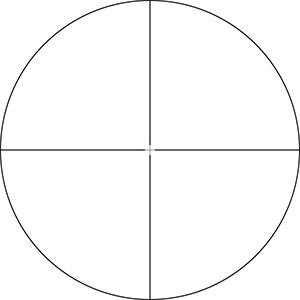
The V Plex reticle is much simpler than the previous BDC. The V Plex is just a MOA reticle style that features a Vortex standard duplex reticle, much like the portion of it that is on the Dead Hold. It also features wider lines that narrow into the duplex reticle at the center of the crosshairs. However, unlike the Dead Hold, it doesn’t feature the marks on the bottom for the BDC and not as many hashes for the elevation or windage adjustment.
This reticle is a great, versatile and well-rounded reticle for any average shooter or for most hunting applications. However, this reticle will not suit long range shooting. This might limit its applications and could be a downfall for some shooters. It also doesn’t feature the BDC marks, which means that holdover will have to be estimated manually. This can lead to some inaccuracy if you aren’t doing those complex calculations or using a BDC reticle.
If you’re not a long range shooter and just looking for a simple optic, this is perfect for you. This optic is made around hunting, which means it will serve you plenty well in basic hunting scenarios, and maybe even some target shooting as well.
It’s very easy to use, which can be an advantage over the BDC. There’s no complex lines to understand or calculations you have to do. It’s pretty much just point and shoot.
It’s also extremely versatile when it comes to average shooting, so you’ll be able to take it anywhere and use it for just about anything. As long as you stay away from extreme distances, you can rely on the V Plex to give you that great shot any time.
Just remember, you can’t shoot any long distances with this reticle.
Just like the dead hold, this reticle isn’t an illuminated reticle. This means that you won’t be able to see it well in darker environments or against backgrounds that the reticle might blend into.
Advantages
- It’s easy to use.
- It’s versatile.
Drawbacks
- It can’t be used for long range shooting.
- It’s not an illuminated reticle.
FAQs
Does magnification affect BDC?
If you are using a riflescope that is in the first focal plane, the magnification shouldn’t affect the BDC estimation. However, second focal plane scope, the reticle will change as you increase or decrease the magnification. This can affect your BDC reticle.
What does BDC stand for on a scope?
BDC stands for Bullet Drop Compensator.
What caliber is the Vortex BDC for?
The Vortex Dead Hold BDC is good for many different calibers. This includes high-powered, magnum, smaller high-velocity, modern calibers, .22, and shotguns. Refer to the previous chart for more specific details.
Does Vortex Optics make a BDC scope?
Yes. Along with the Dead Hold BDC, they offer the Crossfire II and the Vortex Diamondback, both which have BDC features.
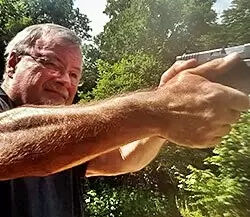
Mike Hardesty is a published freelance gun writer. He also possesses specialized expertise in rifle scopes With dozens of articles and reviews published in Pew Pew Tactical, Snipercountry.com, and TTAG (The Truth About Guns), Mike is considered a firearms expert. His special area of expertise is handguns.
Mike is a long-time shooter. He has been punching paper targets, taking deer and other game and shooting at competitions since about 1975. Other related pursuits include reloading and bullet casting. He currently reloads for over 10 calibers, both handgun and rifle. His reloads, particularly for 9mm, were in great demand during the height of the ammo shortage among family and friends. He donated hundreds of rounds to informal shooting sessions. He was quoted as saying “I do not sell my reloads but I sure will help my guys shoot ’em for free!”. He has a few cherished firearms that he has inherited or otherwise procured — those are his favorites.
He earned B.S. and M.S. degrees from Indiana State University in 1974-1975.
He’s a firearm experts and is the founder of mhardesty.com.
